Where to place a humidifier in a room: choosing the optimal location for the device + expert advice
Home air humidifiers have long been an excellent means of improving the microclimate in a living space. They have been proven to effectively increase humidity levels during dry periods such as winter.
But owners of appliances often encounter all sorts of problems: either a puddle forms, or the tables become covered with a whitish coating, or along with a new useful “tenant,” a loud noise takes up residence in the house, disturbing sleep.
Many of the troubles can be quickly eliminated by choosing the right place to install the device. In this article, we will give recommendations on where to place the humidifier in the room so that it can better cope with its functions.
The content of the article:
Criteria for choosing a location for installation
The choice of location largely depends on type of humidifier, technical characteristics and features of the model itself. For example, a bulky floor-standing unit cannot be placed on shelves or tables, and a compact decorative device is unlikely to cope with humidifying the air in the hall or living room, wherever it is placed.
First, let’s look at what qualities of a humidifier you need to pay attention to when purchasing it, so that you don’t suddenly encounter unpleasant “surprises.” Each of the listed properties in one way or another affects the choice of installation location, temporary or permanent.
Taking into account the characteristics, they decide where it is better to place a home air humidifier: in a spacious living room or in a small office, on the floor or table, in a corner or in the center of the room, on a bedside table or away from rest areas.
It’s easier if you don’t purchase a device for installation in one permanent location, then you can accurately select the device according to your parameters. A device that often “moves” from place to place must be universal, with adjustable parameters and the ability to be installed on any surface.
We recommend that you read best humidifiers for houses and apartments that have received recognition and positive feedback from the owners.
Where is the best place to put a humidifier?
Now let’s “walk” through the entire apartment and find out where an air humidifying device is needed and where it is not. It refers to home appliances that are not purchased for beauty or “to be”, so let’s determine the degree of its usefulness.
Option #1 - kitchen window sill
The device displayed on the window sill in the kitchen is truly surprising. Its appearance in a room where the level of humidity is already sufficient is explained by various reasons - for example, caring for seedlings planted in the spring.
Despite the fact that the kitchen often serves as a dining room and the whole family gathers there, a humidifier is not installed there. Excessive humidity causes the risk of respiratory diseases, swelling of parquet and kitchen facades, mold appearance in corners, along baseboards and under wallpaper.

The only exception is spacious kitchens, the area of which is at least 20 m². In them, the humidifier is placed against a wall located away from the “working area” - the sink and stove.
In studio apartments, the kitchen is often part of the common room, so it is served, along with the rest of the area, by one powerful unit.
Option #2 - bedroom or children's room
Separate bedrooms, as well as the children's room, are classified as recreation rooms - rooms in which family members spend the night. Small children often sleep during the day, so special conditions are observed for them.
If a humidifier is installed in the kitchen in rare cases, then for a bedroom or children's room it is simply necessary. A resting body benefits from fresh air normal humidity: Only in comfortable conditions can a person get a good night's sleep and recharge his batteries for the coming day.
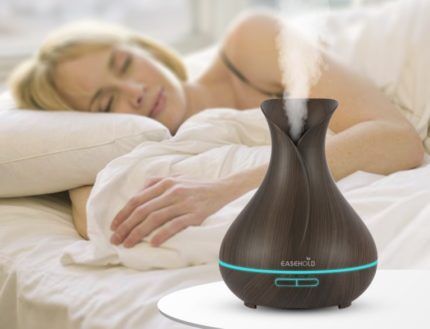
Dryness, on the contrary, greatly harms a person, especially when he is in a defenseless state - sleeping. Therefore, buying a humidifier for the bedroom is the right decision.
But at the same time you need to think about the rules for installing the device:
- do not place it too close to the bed, especially a child’s one;
- choose the quietest device with night mode;
- Do not install the device in the middle of the room or in any other place where you can accidentally stumble upon it in the dark.
If the humidifier is intended for the room of a preschool child, it is better to choose an option with a fun design, but you need to install the device out of reach so that the child does not accidentally drop the device or get burned.
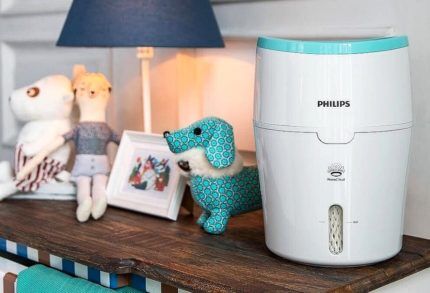
Pay attention to special humidifiers for newborns - low-power and quiet devices with additional filtration and the function of purifying the air from germs and allergens.
But do not forget that ultrasonic devices spray all the impurities in the water into the air. Before placing the device in the nursery, be sure to consult with an experienced pediatrician. We recommend that you familiarize yourself with the pros and cons using a humidifier in a nursery.
Option #3 - a teenager’s office or room
A study room or office is distinguished by the fact that it is intended for work or study.
If in the office one of the adults usually works with literature or technology, or holds business or friendly meetings, then in the nursery the pupil or student also sleeps, so the requirements for installing a humidifier increase.
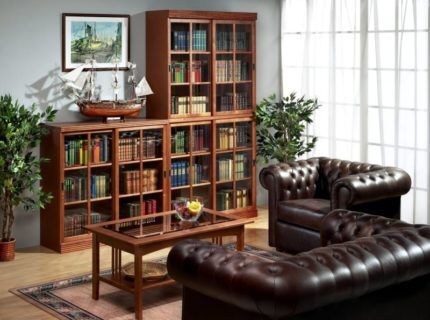
In addition to books, the office may contain expensive computer equipment, which should also be protected from high humidity. If you want to keep rare publications or a brand new laptop safe, place the humidifier away from cabinets and desks.
A small device is sometimes placed directly on the desk. This is possible if the sprayed moisture does not harm paper products and does not cause constant cleaning. It’s better to use a corner or center of the room that is distant from the workplace.
Option #4 - living room or hall
The living room or spacious hall usually serves as a gathering place for all family members to gather and relax together. As a rule, this is one of the largest rooms, well heated and therefore requires additional humidification.
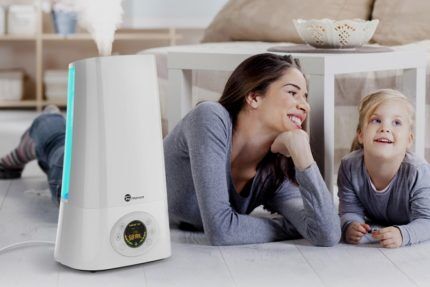
The location is selected after first studying the manufacturer’s recommendations. Floor-standing units are installed exclusively on the floor, having prepared a solid and level base. Decorative compact devices can be placed on a coffee table in the middle of the room, on a windowsill with the sprayer directed towards the center, or on a cabinet shelf, making sure that the “fog” does not damage the furniture.
If the unit is too productive, then at maximum mode a puddle may form around it. Excess moisture is dangerous for carpet, laminate or parquet, but is absolutely harmless for linoleum or tiles.
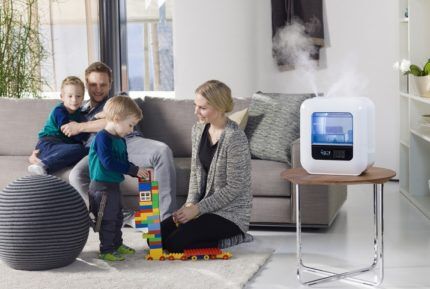
Remember that both natural wood and particle boards swell from high humidity and then shrink if constant moisture is suddenly stopped.
If the room has expensive parquet or furniture made of valuable wood, we recommend that you consult with specialists before purchasing the unit.
Option #5 - greenhouse or winter garden
When buying a humidifier specifically for indoor plants, start by selecting the device by type. This is one of the rare cases when traditional and ultrasonic devices, and preference is given to a steam unit.
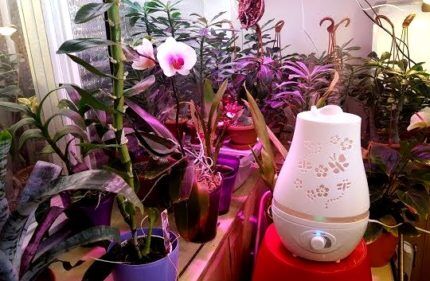
If you decide to install the device on a loggia turned into a winter garden, or simply in a room with a lot of house flowers, think about the placement of both the device and the plants.
Try to keep moisture-loving plants close to the humidifier, and place the rest around the perimeter. Some species do not tolerate constant moisture on the leaves, so you need a device with regulation.
Wherever the humidifier is placed, good ventilation is required. Stagnation of heavy, humid air can lead to rotting of parts of some crops, especially in tight spaces.
The most unsuitable areas for installation
Now let’s look at where you don’t need to install a humidifier.
Rooms that do not require either constant or interval humidification include the following:
- bathroom;
- toilet;
- combined bathroom;
- corridor;
- hallway;
- wardrobe.
In the bathroom and toilet, humidity is always at a high level, so for these rooms it is more important to consider ventilation system, the same applies to the combined bathroom.
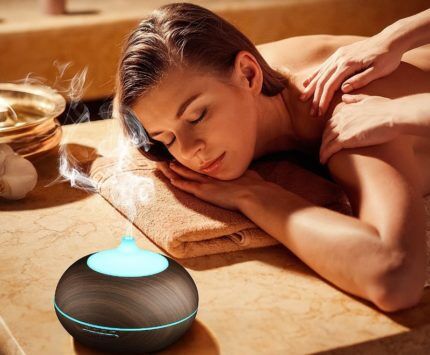
In the dressing room, excess moisture will only cause harm, especially to items of clothing made from natural fabrics and fur.
And in the corridor or hallway, a humidifier will be superfluous, since they already communicate with adjacent rooms.Moreover, in tight spaces, every centimeter of free space is important, so an additional device will do more harm than good.
General rules for choosing a location
It is important to choose the installation location correctly so as not to harm people or surrounding objects. The functionality of the device itself depends on this - if used carelessly, it can suffer, lose its qualities, or simply stop working.
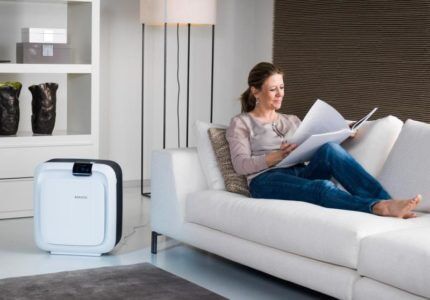
There are several requirements that can be applied to site selection for all types of humidifiers:
- The place must be firm and level. You cannot place the device on a sofa or bed, or on an inclined surface - it must be strictly horizontal.
- Do not move the device while it is turned on. First you need to press the off button, remove the plug from the socket, and only then move the humidifier to another place.
- Do not direct the spray from the sprayer towards furniture or other appliances. They will regularly get wet, and as a result they will lose their attractiveness or fail.
- Try to install even quiet appliances away from beds or sofas - noise increases nervousness and fatigue, and interferes with proper rest.
- Floor-standing models are placed on the floor, others - at a height of 0.5 to 1.5 m. More precise coordinates can be found in the manufacturer's instructions.
- It is better to place potentially dangerous devices in areas inaccessible to small children. Steam humidifiers can become very hot.It is not recommended to inhale the mist of ultrasonic devices at close range.
- Humidifiers lose effectiveness if they are placed near heating elements or open flames - radiators, heaters, fireplaces or stoves - as the moisture dries out immediately.
Do not install the device in places convenient for movement: you may accidentally hit and break a device standing on the road.

And if there are active animals in the house, try to protect equipment from these energetic and curious pets.
In addition to choosing the optimal location for placing the device, it is equally important use it correctly and timely service, cleaning from scale and mold.
Conclusions and useful video on the topic
Brief recommendations from Ballu dealers:
Features of choosing and installing humidifiers for children:
As you can see, choosing an area to install a humidifier is just as important as choosing the device itself. When determining the location, you need to take into account the manufacturer’s requirements, the characteristics of the device, and environmental conditions.
Don’t forget that all models require constant maintenance - ensure easy access to the device, the ability to quickly adjust and turn it off. The result of your efforts will be a healthy, comfortable microclimate - a truly homely atmosphere and comfort!
In what room is your humidifier installed? Share with other users your experience of placing and operating the device, tell us about the problems you encountered when choosing the wrong place to install the humidifier.



